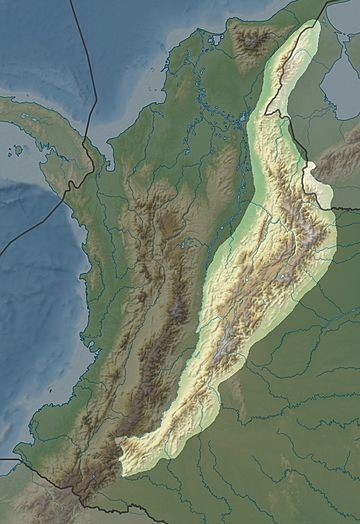Cordillera Oriental (Colombia) facts for kids
Quick facts for kids Cordillera Oriental (Eastern Ranges) |
|
|---|---|
 |
|
| Highest point | |
| Peak | Ritacuba Blanco |
| Elevation | 5,410 m (17,750 ft) |
| Listing | Altiplano Cundiboyacense, Serranía de los Yariguíes, Serranía de las Quinchas, Sierra Nevada del Cocuy, Serranía del Perijá |
| Dimensions | |
| Length | 1,200 km (750 mi) SW-NE |
| Area | 144,252 km2 (55,696 sq mi) |
| Geography | |
| Country | Colombia |
| Parent range | Andes |
| Geology | |
| Age of rock | Neoproterozoic-Holocene |
| Mountain type | Andean Subduction-related orogen |
The Cordillera Oriental (which means Eastern Ranges in English) is the widest of the three main mountain chains that make up the Colombian Andes. Imagine the Andes Mountains as a giant tree, and these ranges are its biggest branches!
This mountain range stretches from south to north. It starts in the Colombian Massif in the Huila Department and goes all the way to the Norte de Santander Department. There, it splits into two smaller ranges: the Serranía del Perijá and the Cordillera de Mérida in the Venezuelan Andes. The very highest point in the Cordillera Oriental is Ritacuba Blanco. This peak is an amazing 5,410 m (17,750 ft) tall and is found in the Sierra Nevada del Cocuy.
Geography of the Eastern Ranges
The Cordillera Oriental is a very important part of Colombia's geography. The western side of these mountains feeds into the Magdalena River basin. This means that water from the western slopes flows into the Magdalena River.
On the other hand, the eastern side of the Cordillera Oriental is home to the beginnings of much larger river systems. These include the famous Amazon River, the Orinoco River, and the Catatumbo River.
Inside this mountain range, you'll find some unique places. One is the Altiplano Cundiboyacense, which is a high plateau. Another is the Sierra Nevada del Cocuy, which is special because it has the only snowy peaks in this entire mountain range. The Cordillera Oriental also has more páramos than anywhere else in the world! A páramo is a special type of high-altitude ecosystem, often misty and full of unique plants.
Different parts of the Cordillera Oriental are covered by various types of forests and ecosystems. The eastern slopes and the northern end are covered by the Cordillera Oriental montane forests. These are forests that grow in mountainous areas. The western slopes have the Magdalena Valley montane forests. At the very highest parts of the mountains, you'll find the Northern Andean páramo, which is the cool, misty land we just talked about.
Amazing Protected Areas
The Cordillera Oriental is home to many beautiful and important protected areas. These places help to keep the unique plants, animals, and landscapes safe. Here are some of them:
- Cueva de los Guácharos
- Chingaza National Natural Park
- Yariguíes National Park
- Sierra Nevada del Cocuy
- Sumapaz Páramo
- Tamá National Natural Park
- Los Estoraques Unique Natural Area
- Lake Iguaque
- Guanentá Alto Río Fonce Flora and Fauna Sanctuary
- Catatumbo Barí National Natural Park
- Los Picachos National Natural Park
- Pisba National Natural Park
See also
 In Spanish: Cordillera Oriental (Colombia) para niños
In Spanish: Cordillera Oriental (Colombia) para niños
- Geography of Colombia
- Altiplano Cundiboyacense, Bogotá savanna, Tenza Valley
- Cordillera Central, Occidental, Andean Region, Venezuelan Andes

